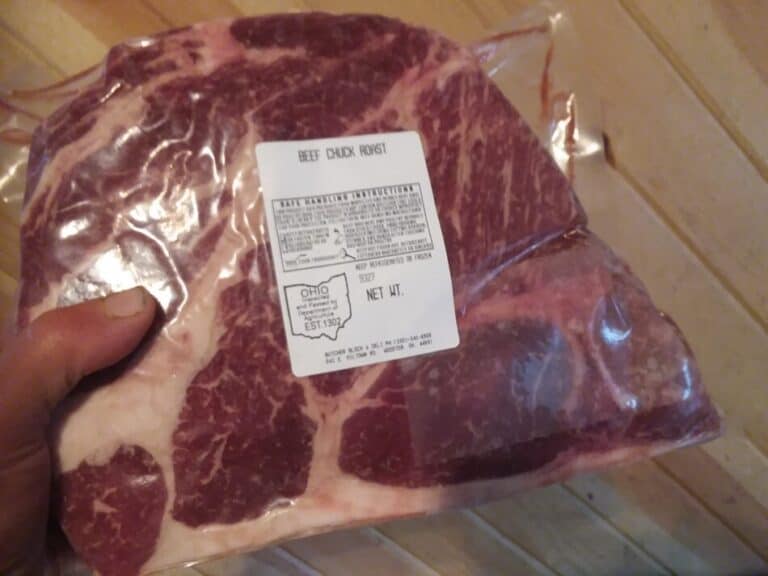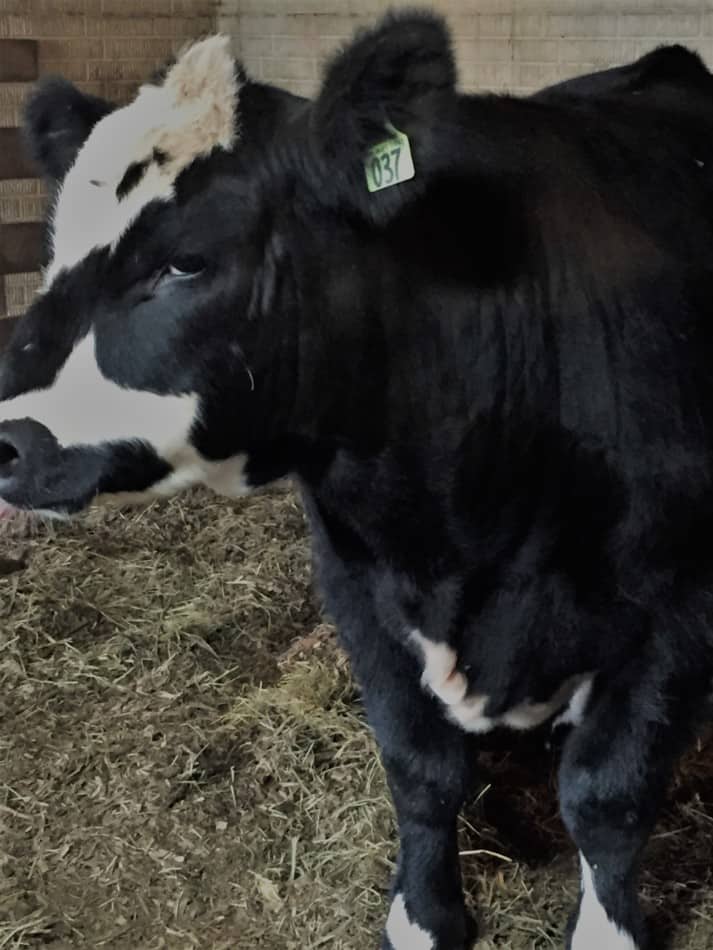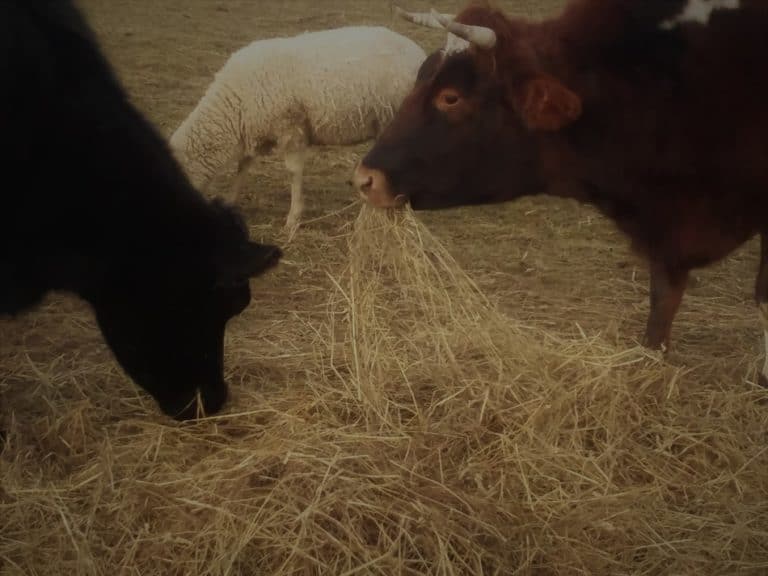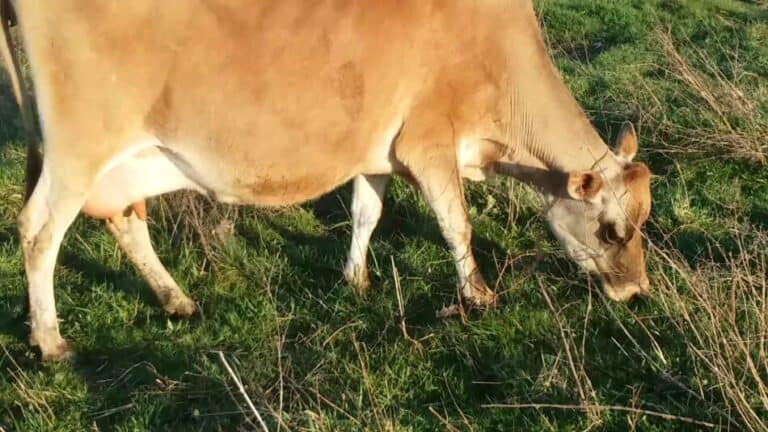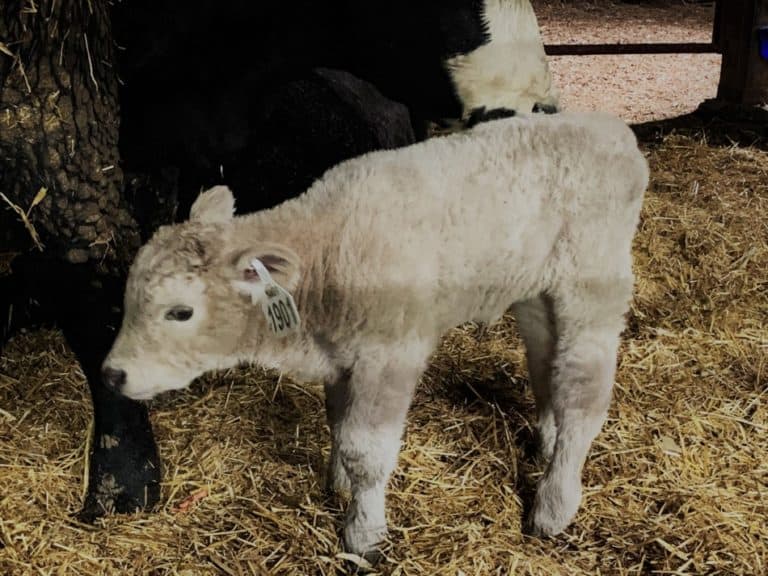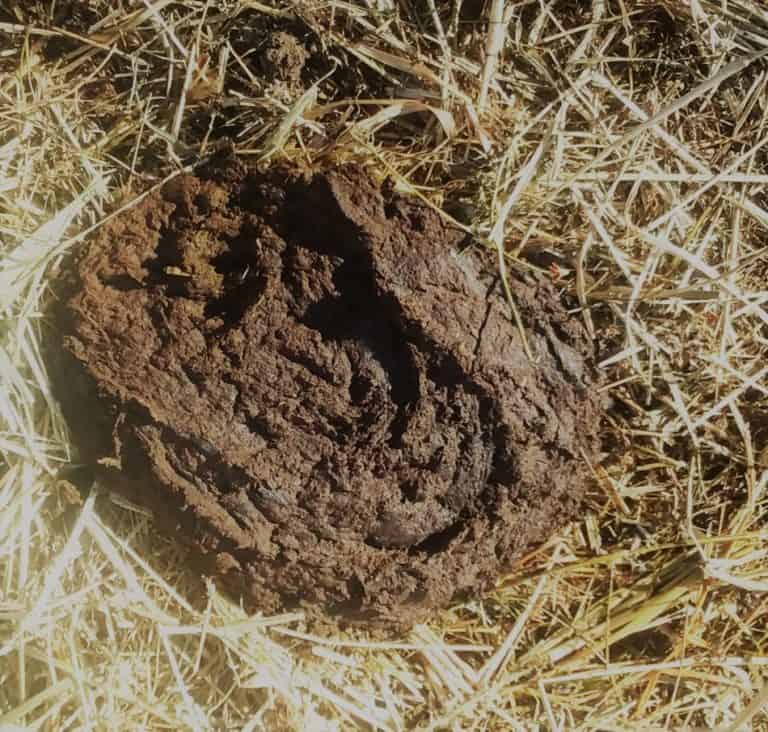Getting Started With Cattle: The Basics You Need To Know
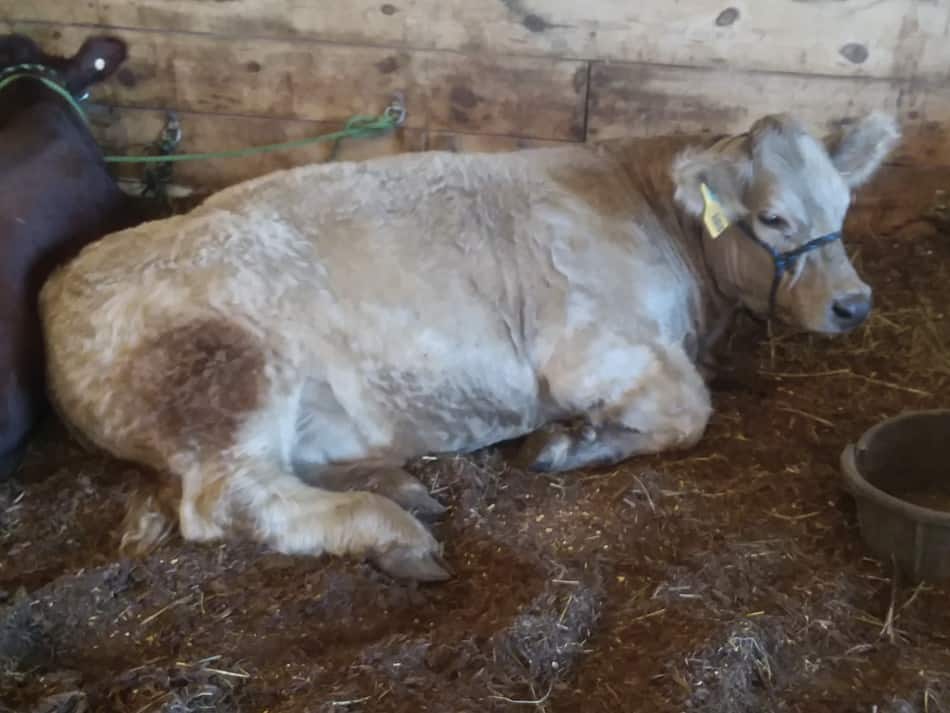
Considering getting a few head of cattle for your acreage? Great idea! Cattle are livestock that can work for you and feed you at the same time.
Plus if you get breeding stock you will have extra animals to sell to neighbors or just the local auction to help you new hobby pay for itself.
The cattle basics you need to know when you are considering getting your own herd of cattle are feed, handling, reproduction, pasture management and cattle behavior.
Let me be very upfront with you regarding money, most cattle will not be money makers for you, especially since you are just getting started.
Is Raising Your Own Beef Worth It? will go over the things you need to plan into your budget, including butchering costs, to go from feeder steer to a freezer full of beef.
What they will do for you is eat down your extra grass and fertilize the soil turning a non edible plant into a little extra money by selling the grown animals or in savings over what you would pay at the grocery store.
We’ll go over the basics all new to cattle folks need to know.
Cattle love routine
Cattle love to function as a group, the herd gives them companionship and security. Cattle also love routine.
For instance they will learn that when you show up and open up the fence, they should walk through to new grass.
They will also learn the patterns of your behavior that mean they are not going to like whatever happens next.
For instance, if you put them in the barn and then put them in a head gate in the corner of the pen, for shots or deworming or get a closer look at an injury, they will remember it and avoid that head gate in the future.
No surprise here, since you would do the same.
Behavioral Principles Of Livestock Handling is an article by Temple Grandin that will give you a good start on understanding cattle.
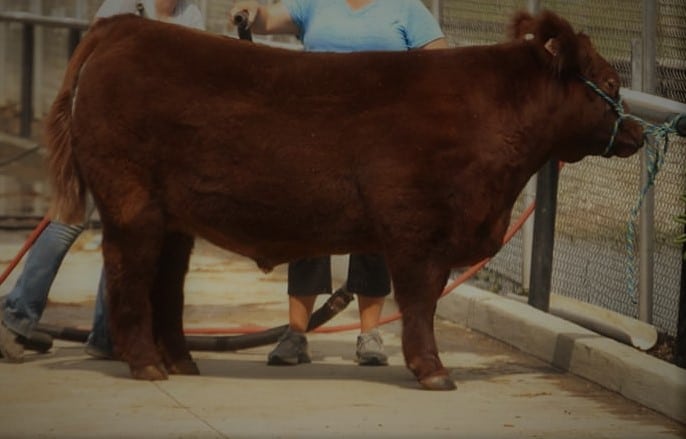
Have the cattle familiar with the working facilities
If you want the cattle to go into an area when you are on a timeline you need to have them “practice” so whatever you are doing is just a normal thing for them.
If the cattle have had negative experiences in the place you want them to go, or it is just unfamiliar to them they will resist.
This leaves you with force as your only option, not a good place to be.
Think ahead a little and use their love of routine and food to help you.
Feed them a little grain in the head lock regularly so when you need to catch them they are less leery.
Or run the cattle through the working corral to get out of the barn. This makes the corral a normal place to go, so they will be more cooperative.
Large cattle ranches will handle cattle differently than you
I do have to point out that farmers and/or ranchers with hundreds, maybe even thousands of cattle do not run their cattle operations this way.
They have to be more efficient than a small producer just getting started.
These cattlemen have tons of experience, knowledgeable help and cattle ready facilities.
Chances are you don’t have any of the three, let alone all of them!
Your approach to cattle behavior and management needs to be appropriate for your experience level and herd size.
Choose cattle from a trusted source
Always buy healthy animals from a source that you can trust.
Chances are this will cost you a bit more than buying them at a livestock auction, but it will greatly reduce many of the problems you will face if you just start out right.
Buying Your Beef Starter Herd will go over the things you need to look for when seeking out your first herd of cattle.
Look at overall health of the cattle
Use common sense here, look over the whole animal. Does it have good body condition, a nice hair coat and a calm demeanor?
How’s the conformation (structure of the body) of those brood cows and heifers?
Your calves will be a combination of their parents in looks and behavior, so consider what traits you are choosing to reproduce.
Read the post What To Look For When Purchasing Livestock.
To get the same results you must do the same things
How many calves does the owner pull every year, or are the cows expected to give birth unassisted?
Whatever the current owner does with the cattle to get this level of performance you will have to do as well. Is that what you want?
What are they being fed? A calf that looks great because it is eating a bunch of creep feed will not gain as well for you without the creep feed.
Neither is right or wrong, just make sure you are comparing what you think you are comparing.
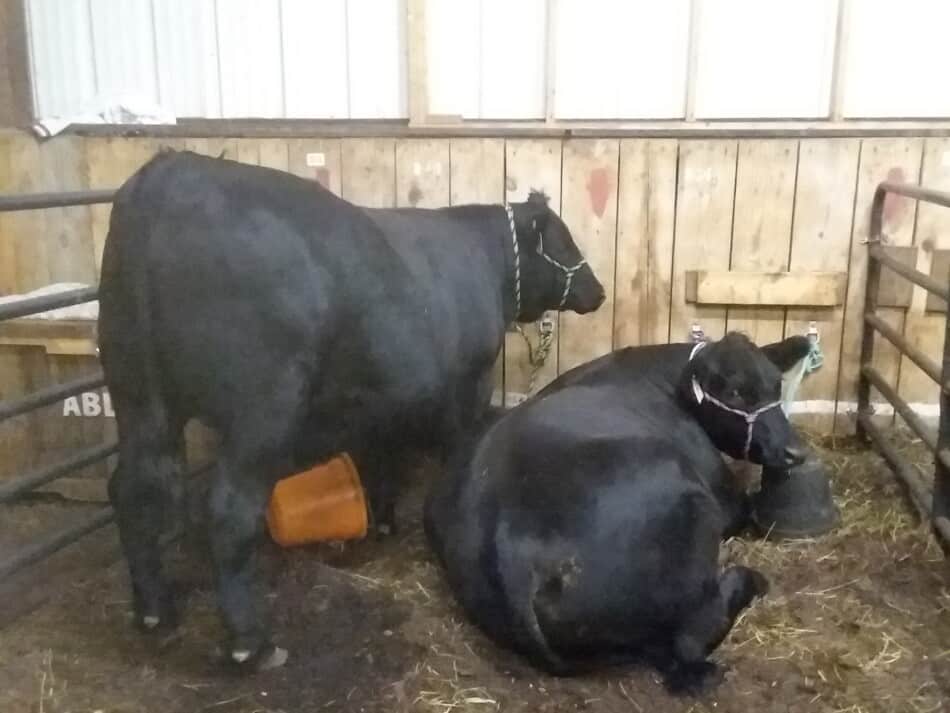
Buy high quality cattle to start with
Buy the best you can afford, quality pays.
Don’t get hung up on breed, get structurally correct, calm cattle that will economically produce for you.
Make sure to get cattle that fit your system, for instance raising Highland cattle in an area of extreme heat is a bad idea, they will not do well.
However, in a cold more harsh environment they would be perfect.
Cattle need a working corral
You’ll need to have a place to put your herd that is secure and has enough space for all of the cattle to fit into a pen or a combination of pens in a corral system.
Getting all of them in at once allows you to do health treatments like deworming or be able to sort off animals to sell.
Additionally, if you want to do any artificial insemination (A.I.) with your herd you will need the ability to hold them reasonably still for the technician.
Have a plan to easily move cattle
None of this needs to be complicated but it does need to be figured out.
If your cattle have been bucket trained, they will come to you since they want the grain.
Bucket trained just means that the cattle know when they see you with a bucket they are about to get a snack.
Give them a few days to get used to the pen before they have to be in it. Then they will be familiar with the inside of the barn and go in easily to get the feed.
Cattle have some size and power, you will need pens and gates to be sturdy and secure for your herd.
You have fencing options for your cattle
Fencing wise, electric or woven wire both work great.
Be aware since cattle are as tall as the top of the fence, if it is not electric, they can put their heads on top of the fence and push it down.
This is why many farms have a strand of electric along the top of the fence, to keep the animals from smashing it down by trying to reach or jump over.
Cattle, especially heifers, that are in heat are particularly prone to this type of fence abuse.
Another fencing option is barbed wire, especially in areas where you can not get electric. Barbed wire is the culprit in some nasty cuts when the animal does tangle with it.
Consider using electric fencing for the herd
If I wanted to put up fence for my cattle in an area that currently did not have any fence, I would seriously consider electric.
Electric fencing is versatile and affordable, especially when compared to woven wire.
It is also pretty fast to set up and move if you get the polywire. Single strand regular wire can be moved as well, but it is more challenging.
Use polybraid for pasture divisions
If you are planning on frequent moving of the fence line use polybraid, since it is easily rolled back up on a reel then strung out again.
Polybraid is a plastic cable with small strands of metal wire woven through it. Polybraid is very flexible and portable.
We use electric to divide off the sections of the pasture we want the animals to have access to and for part of the perimeter.
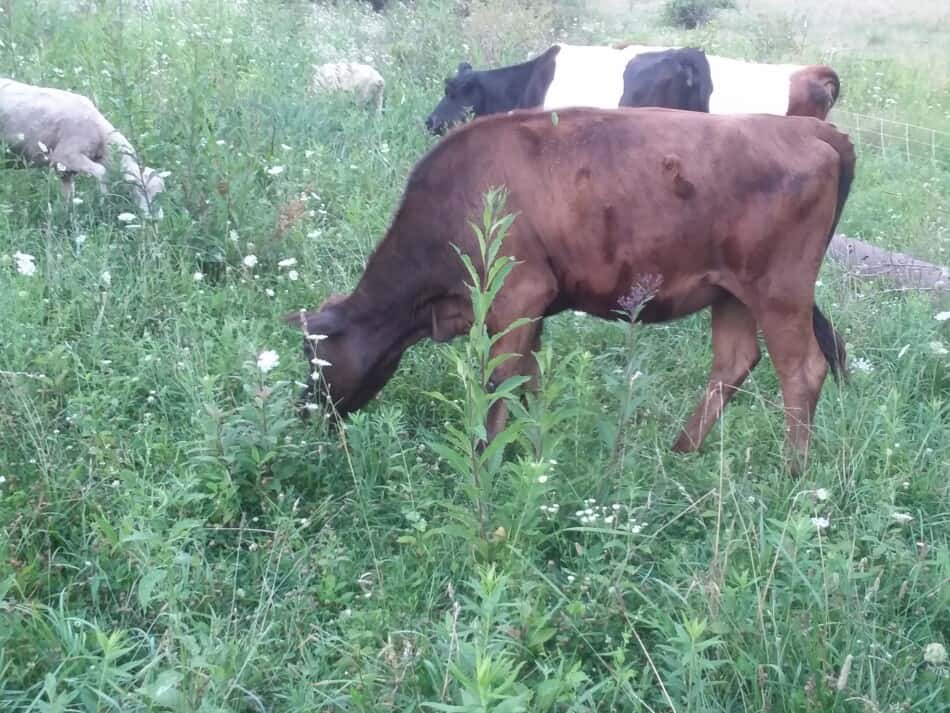
A woven wire perimeter is secure, but pricey
We are putting up a full perimeter of woven wire fence, since we feel it is more secure than just electric because we graze mixed species.
However, many of the cattle owners around our area use electric perimeters, generally at least two strands, that seem to work well.
Woven wire fencing takes time and significant cash, so we are progressing but are not done.
If you are able, put up a woven wire perimeter and divide your land off with electric. If not, start the less expensive way and go all electric fencing.
Electric fence will not handle crowding
Electric fencing:
- can not be crowded against
- mixed species may require more extensive fencing
If you are going to push or force the animals in an area, this area must have a solid, non electric, fence.
This means any handling area must be made of wood or metal, not electric fence.
Crowding the cattle together, like to load them on a trailer, will have them pushing and shoving through the electric fence. Not good.
If you are grazing mixed species, we have sheep and cattle together, the fence will need to be the type that keeps in all of your animals.
In our case, the sheep need netting while the cattle will be great with just a single strand of electric wire.
Cattle may need purchased feeds
The most basic feeding system is just grass or other forages in the pasture. If you have plenty of land, wonderful! Managed well, you can graze nearly year round!
Give the herd a salt block and plenty of water and they are good to go for the summer, all you need to do is move them to a new area as they finish up the grass where they are.
How To Choose High Quality Hay goes over the things you need to check to make sure the hay you are buying is worth your money.
Feeding hay in winter is common for cattle
In the winter things are a little more complicated, but not by much.
Hay for your herd should be of high quality, mostly first cutting grass hay. Smell the hay and check for mold or tons of weeds.
A nicely made first cutting grass hay will be the ticket for wintering your new herd.
The super green hay that is only alfalfa is probably too rich for your cattle, they need the longer stems of the grasses to have their digestion work properly.
Grain not needed for mature cattle
As far as grain goes, if your cattle, cows especially, are keeping in good condition then they don’t need any grain, it will just make them fatter.
Any cattle that you want to grow a bit faster, like steers, or seem to be needing more nutrition from their feed than they are getting could be given grain to make up for the calories they are not getting elsewhere.
To be clear, cattle do not need grain. They can and do grow just fine on forages alone.
Grain can increase gains in cattle
Sometimes it is more economical to use grain, rather than just forage, to make sure the steers are eating all the calories they need for the day.
If you decide that feeding grain is right for your situration, keep the amount of grain per steer low and introduce it gradually, too much grain upsets their bacterial balance in their gut.
For the health of the animal, most of the feed needs to be forage even if you supplement with some grain.
Deworm your cattle before increasing feed
If you are disappointed with the growth of your cattle on pasture and feel that they should be growing better than they are currently, consider deworming them before adding grain.
If your hay or pasture is of acceptable quality, deworm your cattle first before buying grain.
Many times poor performers are carrying a heavy parasite load.
Adding grain without deworming is feeding the worms, not the animal growth you are wanting. Be sure to eliminate the parasites first.
Pasture management for cattle
Pasture management is separate from feeding, since it is more involved and you have some choices to make regarding your priorities.
Grazing Cattle: Using Grass To Feed Your Herd goes deeper into raising cattle for regenerating your pastures.
Are you choosing to keep the cattle out on the pasture no matter what the grass is like? Or are you going to move the cattle to optimize grass health?
Realizing this means you may need to get the animals completely off of the pasture until it has time to grow back, so they will need to be in a sacrifice pasture or in the barn until the pasture is ready to be grazed down again.
The right way to graze improves the soil
Which is the right answer? This depends upon your situation and your goals. The right answer is always improving soil health.
Have a plan, so your pasture will be more productive next year.
Without a plan, chances are you will loose production in your pasture, most likely due to overgrazing and compaction.
Spend time in the pasture with your cattle
Spend some time in the pasture with your cattle.
How are they doing? How is the grass?
Move them when they have worked over the area and keep them off of it until it has regrown.
The more time you spend with your cattle, the better your animal husbandry skills will be. Learn your herd.
Cattle reproduction is cyclic
If you are wanting to grow your herd, then this section is of special interest to you. Here are some terminology basics first:
- calf-baby bovine male or female
- heifer-a female bovine that has not had a calf yet, she is a heifer when she is 1 day old or 1 year old
- cow-female bovine that has had at least one calf, so she is a mom
- bull-male bovine that is the father of the calves
- steer-male bovine that is castrated, so his future is beef only
Well grown calves become productive cows
Beef calves stay with their moms for the summer.
Depending upon the management system, they could be separated off into a peer group at weaning or the replacements could be left with the herd.
Calves that have a good start and are well grown will perform better as adults.
Breeding age heifers calve at 24 months
Most cattlemen want their heifers to have her first calf at two years old.
At two the heifer should be well grown herself so she can easily support a pregnancy and produce a healthy calf.
Heifers start to come into heat around 6-8 months of age, so they can breed to calve much earlier than two years if they are left in with a breeding age male.
This is not a good thing, she will be too small to be a good mom. Separate out heifers from intact males.
Brood cows should be in good condition
Use the month or two before breeding to get your brood cows (moms) in good condition for breeding.
Too fat or too thin are both problematic.
You will nave the most successful breeding season if the cows are in ideal shape.
Calves can be born anytime of year
Cows are able to have a calf at any time of the year.
Cows come into heat every 17 days, throughout the year and have a 9 month gestation length.
If you want your calves to be born in late April to early May then the cows need to be bred in late August to early September.
The cows will probably not all settle (establish a pregnancy) in the first heat cycle but should be able to all be bred in two cycles.
Keeping the calving window tight is ideal, depending upon the number of cows you have per bull you might need more heat cycles to get all the cows bred.
Being productive is your cow’s job
Cows are kept in the herd as long as they are continuing to be productive, after all this is her job, you don’t work you don’t keep your job.
Many cows, especially beef cows can preform well in your herd for more than ten years.
You’ll soon begin to figure out the better cows for your situation and it will be apparent that this “better cow for you” traits are genetic.
If you are planning to grow your herd by keeping replacements, keep heifers from your best performers. You’ll be glad you did!
Bulls have huge genetic influence on herds
Bulls are the most important factor for your breeding season from a genetic perspective.
Like it or not a bull himself is half the genetics of the calves that will be born in the spring.
That’s a ton of influence-get a good one.
Bulls should be in breeding condition
Bulls also need to be kept in breeding condition, too fat or too thin are both a problem. He also needs to have good feet and legs.
If he is not feeling like walking because of a sore foot he will not breed as many cows as he should be breeding and that will spread out your calving window.
A bull in good condition has an overall healthy look about him, a nice hair coat and moves freely.
Additionally, look at the scrotum (the sac that holds the testicles), both sides should be even in size and in this case bigger is better, since scrotal size is related to fertility.
Farms and ranches that sell bulls as breeding stock measure scrotal circumference to compare one bull to the next.
Since you are new, just go with a visual inspection.
Steers are castrated male calves
Steers are bull calves that are castrated, meaning they have had their testicles removed, so they are for beef only.
Steers will be easier to manage than bulls, or heifers for that matter, if you just want to raise a small few cattle for beef.
The steer will not develop the muscling of a bull, since the extra muscling on a bull compared to a steer is a function of the testicles producing testosterone in the bull.
Steers are easier to raise than heifers
Compared to a heifer, a steer will be more level in his attitude and will gain weight better, simply because as a heifer comes into heat she stops eating as well as she did before.
A heifer in heat becomes more active and, to be bunt, more difficult to deal with. This is just hormones and will only last a few days.
For more information on raising heifers for beef, here is an article from Michigan State University Do Steers Or Heifers Produce Better Beef?
In a steer, you don’t get the hormone fluctuations, so the weight gains are more predictable compared to the feed eaten.
If you are just looking to raise beef for yourself or to have cattle eat down your pasture for you get a few steers, they will be the easiest to get along with.
Handling your cattle will be needed
Eventually, you will need to handle your cattle for one reason or another.
Routine health checks and dewormings or to catch them up for the vet, it will definitely happen so you need to be ready.
Make sure your cattle are familiar with the corral
First off the easiest way to handle any animal, cattle included, is to make whatever you plan to do a part of their normal activities.
Meaning if you want to catch up your cattle in a barn make sure they have been in that part of the barn before. Ideally, in a non stressful situation like feeding them.
Bucket train cattle for easy moving
Another super easy thing to do is to bucket train your cattle, by this I mean when the cattle see you carrying a bucket they should be interested and start to head your way for the grain.
How do they know you have grain (or some other snack)? They know about the bucket having grain because you have shown them through routine that you bring a bucket and they get grain.
You can get this training started by putting out a bit of grain for them in a trough then back up to give them space to check it out.
If they are hesitating it is because they have to make sure it is not a trap or something that will hurt them, normal precautions to all new situations or things.
If the cattle won’t come too close leave, your staring or being too close is putting them off.
How close is too close? It depends upon the individual animal, just back off until they seem at ease.
Cattle are ruled by their stomachs so pretty soon they will lose their shyness, at least where grain is concerned.
Your cattle should like the idea of going into the pen
Why go into such detail here?
Getting the cattle to think that going into an area is their idea is by far the easiest and safest way to get them into a pen.
Forcing them to go where they don’t want to always is more risky, since one of you can easily be hurt.
Have a working chute and head gate
For the times when you need them to be handled, most farmers and ranchers use a head gate and a working chute.
A head gate is a gate that when the cow puts her head through the bars it moves over and lock her in.
The chute is an open ended self supporting cage/box at the end of the funnel of gates or fence to get the cattle to the head gate.
Once in the chute and head gate the cow can be vaccinated, ear tagged, or have any other individual treatment taken care of.
Head locks are handy for cattle containment
Some farms have a section of head locks, where the animal reaches through to eat and the pipe slides over and catches her head.
This is what we had for our heifers. It works great since they reach through the head locks to eat every day, the time when you want to catch them is no different.
I have to admit getting a heifer that is in heat to cooperate is always a challenge, but other wise these work well.
If this set up is not in your budget, you can use a gate to securely tied in the corner and squeeze the cow to hold her still, but this is risky especially to you.
A more secure method is to put in a locking head gate in a place where it is well anchored.
They stick their heads through the opening, a pipe slides over and automatically locks them it.
The hind end can still swing around in a half circle but the front should be secure.
Related Questions
How many cattle can I have per acre?
This completely depends upon the forage production of your pasture and the management system you are using.
In our part of Ohio, cattle can be kept at one cow and her calf per 1.5-2 acres.
Why is grass fed beef more expensive?
Grass fed beef is more expensive because it takes more time for cattle to grow to finishing weight on forage alone rather than on grain.
Grass fed is healthier for the animal and you, but it does mean that the person raising the grass fed cattle has more time spent caring for the animals before getting paid.
